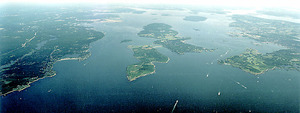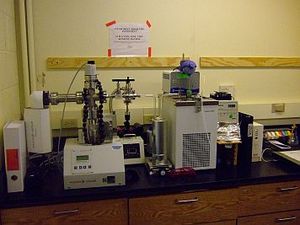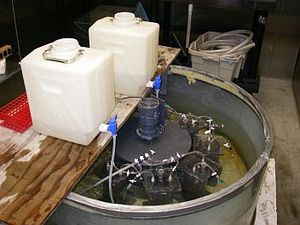Quick, when I say "ocean" what are the images that come to mind? Humpback whales breaking through blue water or maybe miles of coral reef guarded by brightly colored fish. But what if I told you that the smallest things, those that can't be seen with the un-aided eye, are also worthy of exploration. In the water running seaward and in the sand and mud at your toes - there is life. Life that is responsible for the recycling of nutrients and sometimes the cleansing of water.
It turns out that microscopic forms of life living in marine sediments play a crucial role in regulating the amount of nutrients (nitrogen and phosphorus) in the water column. We care about the amount and kinds of nutrients in the water because they feed microscopic plants (phytoplankton) that form the basis of the food web. When it comes to marine systems we are primarily concerned with nitrogen. Nitrogen has the most profound impact on coastal systems because it is the limiting nutrient. That is, it is often the least abundant relative to the amount required to form life, so phytoplankton growth is restricted by the supply of that nutrient.
Nevertheless, while nitrogen is necessary for plant growth, too much of it released into the marine environment can have dramatic negative affects. Excess nitrogen can trigger unusually large phytoplankton blooms that shade the water and make it impossible for other aquatic plants, such as eel grass, to survive. And when the phytoplankton bloom dies and sinks to the bottom, the decomposition process uses up the available oxygen, which kills fish, shellfish, and other bottom-dwelling organisms. Unfortunately, humans introduce nitrogen into the environment in many ways, including burning fossil fuels, fertilizing fields and lawns, and through human waste.
The nitrogen cycle is complex and many processes work to keep nitrogen within a system. Only one process, known as denitrification, permanently removes nitrogen. It occurs in land, freshwater and marine ecosystems and is a form of bacterial respiration that converts biologically usable forms of nitrogen (i.e. nitrites, nitrates, and ammonium salts) to an unusable form, chiefly nitrogen gas, N2.
|
This is an example of a sediment core collected from the estuary. The silver you see at the top is part of the corer. The grey base you see hold the sediment in the core tube. In this sediment core you can see a moon snail in the middle. |
Denitrification is important because it is the dominant nitrogen removal route in estuaries and the continental shelf. It occurs naturally and can remove a substantial portion of the total nitrogen load to the estuary. In a sense, it is nature's cleanser for the estuary - removing the nitrogen and therefore combating the negative effects mentioned above. Because denitrification is so important, estuaries have been described as "filters" or "sinks."
We set out to measure this process in a temperate estuary called Narragansett Bay along the northeast coast of the United States. We began by collecting sediments throughout the estuary and bringing them back to the lab. Once in the lab we sealed the sediments and the overlying water together in a gas tight container and over time extracted water samples. We then used an instrument that can precisely measure dissolved gases in water called a membrane inlet mass spectrometer.
In 2005, we learned that the rate of denitrification had decreased substantially since it was first measured here in the late 1970s. The cleansing process that is so vital for maintaining the estuary had slowed. We continued to sample through 2006 and we discovered a remarkable change. Instead of producing nitrogen gas through denitrification, the sediments began to do the opposite. That is, they were instead fixing nitrogen.
|
The membrane inlet mass spectrometer, otherwise referred to as MIMS, requires a small size and no sample preparation. In addition the instrument can process water samples for dissolved gas concentrations quickly (about 20 to 30 an hour) and very precisely. |
During nitrogen fixation bacteria in the sediment take nitrogen gas and turn it into a biologically usable form of nitrogen (for example nitrate or ammonium). To visualize this change - imagine the sediments breathing. When denitrification dominates the sediments are exhaling - cleansing the water of excess nitrogen. But, when nitrogen fixation occurs the sediments inhale - bringing more nitrogen into the system. In fact, we found that the sediments added more than 1.5 times the amount of nitrogen from the land and atmosphere combined in the summer of 2006. This is a major shift from the estuary acting as a nitrogen "filter or sink" to acting as a nitrogen "source".
Finding nitrogen fixation in the sediments was surprising and also a bit worrisome. Most organisms cannot fix nitrogen and it has long been thought that this process was generally not important in marine sediments. What would cause this dramatic shift? And what might it mean for estuaries and the global ocean?
To answer these questions we began exploring other ecological changes that have occurred in the bay. In the thirty years since denitrification was first measured the average annual water temperature has increased by 1.5ºC and finfish have been replaced by crabs and lobsters. Most dramatic of all has been the shift in the timing and magnitude of the winter-spring phytoplankton bloom that once characterized this bay. The amount of phytoplankton in the water column has decreased by almost 40%. This decrease is important because in coastal systems the phytoplankton fall to the bottom and feed the organisms that live in the sediment. Without this pulse of food or organic matter the organisms cannot survive.
|
The sediment cores, sealed with a gas tight lid, in a water bath. The water bath allows us to maintain the field temperature for the sediment cores. The whole set up is placed in an environmental chamber - again allowing us to control the temperature so we may look at seasonal changes in sediment nutrient cycling. When we extract a sample for analysis we replace the water from the two large white containers that holds filtered site water. The large grey circle in the middle has a motor that turns high powered magnets attached to a plastic plate. In each of the sediment cores there is magnet attached to the lid. As the plastic plate moves it causes the magnets inside the sediment cores to move too. This helps us keep the water above the sediment constantly stirred to mimic real environmental conditions. |
We thought that this decrease in organic matter might also be responsible for the flip from denitrification to nitrogen fixation. So we designed a series of experiments that would test our hypothesis. We added varying amounts of organic matter to individual sediment cores as well as large four square meter sediment plots. The sediments that received the fresh organic matter were all denitrification dominated and the sediments with no organic matter were all fixing nitrogen. So now we think we know what caused the switch - the bacteria responsible for denitrification need fresh organic matter. We also think we know why the phytoplankton production has decreased.
The decrease in phytoplankton production over the last thirty years has been increasingly linked to changes in climate. There are two main working hypotheses and it is important to note that both might be responsible. The first is that the warming waters of the bay allow zooplankton, which are microscopic animals, to feed or graze down the phytoplankton earlier and longer. If this is the case, the phytoplankton never reach "bloom" capacity because the zooplankton eat them too quickly.
The other hypothesis is that warmer winters have more cloudy days and conversely colder winters have more sunny days. Lots of research, here in Narragansett Bay and in other regions such as the Gulf of Maine and the Baltic, has shown that the onset of the winter-spring phytoplankton bloom is determined by the amount of light the phytoplankton receive. If the phytoplankton get less light then this could also decrease the overall amount of phytoplankton growth.
The long term effects of what we observed last summer still need to be explored. The next step is to determine how much of the fixed nitrogen is recycled into the water column. This will help us to determine if the fixed nitrogen can affect other ecological processes in the bay. We also need to see if nitrogen fixation is taking place in other estuaries and along the continental shelf. Since these areas are hot spots for nitrogen removal through denitrification, should they switch to nitrogen fixation, it could have important consequences for the open ocean.













Comments
Add a comment